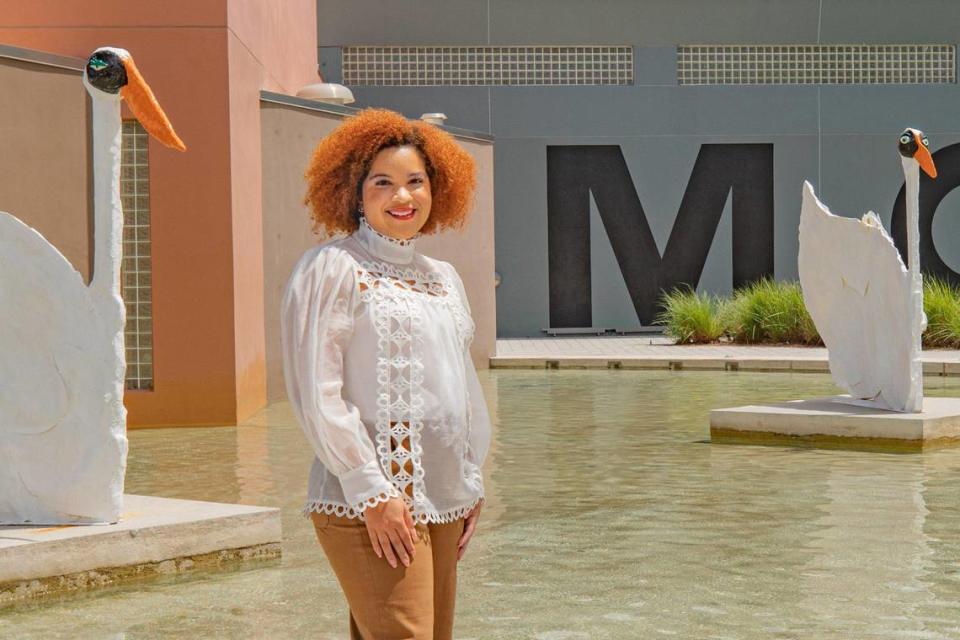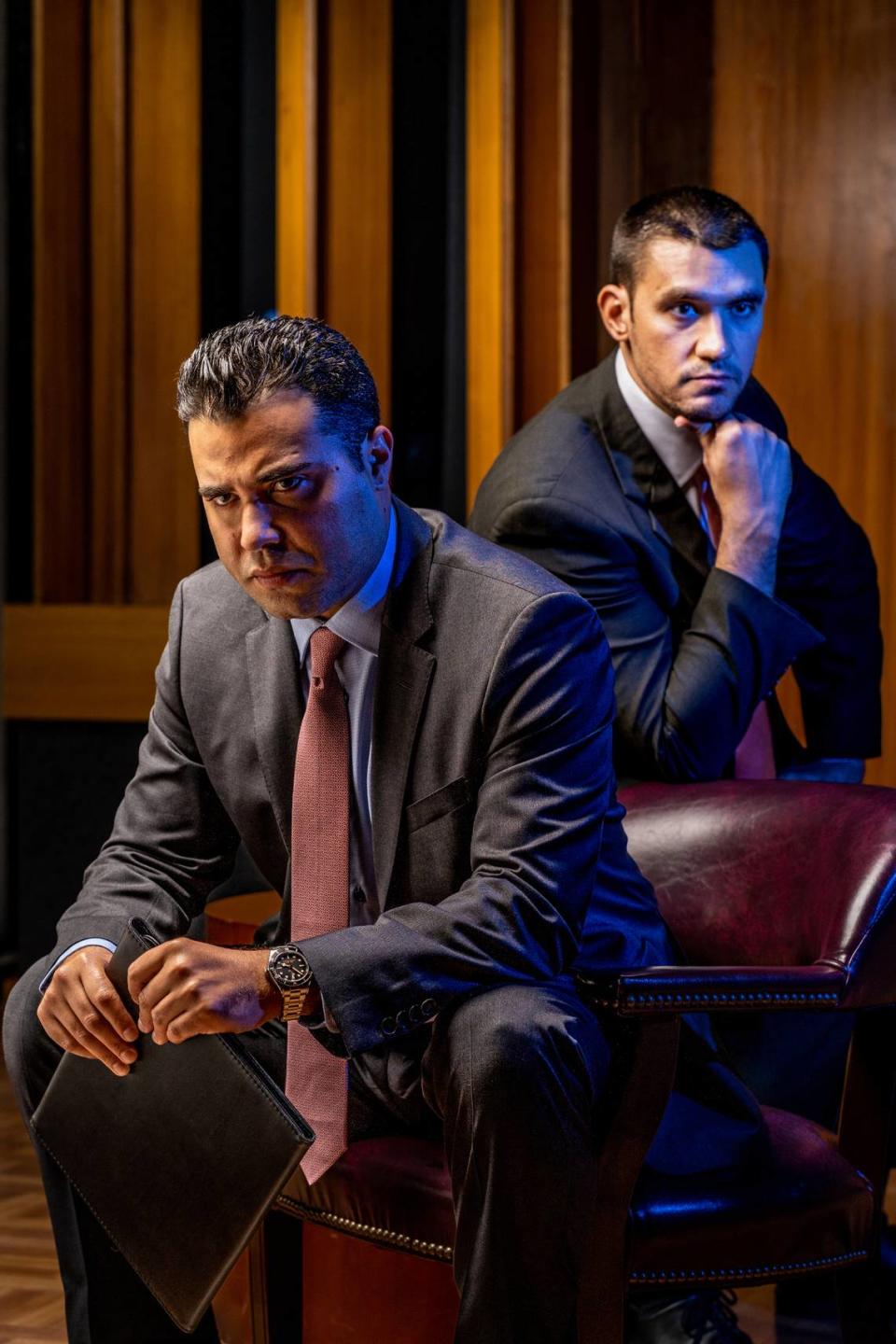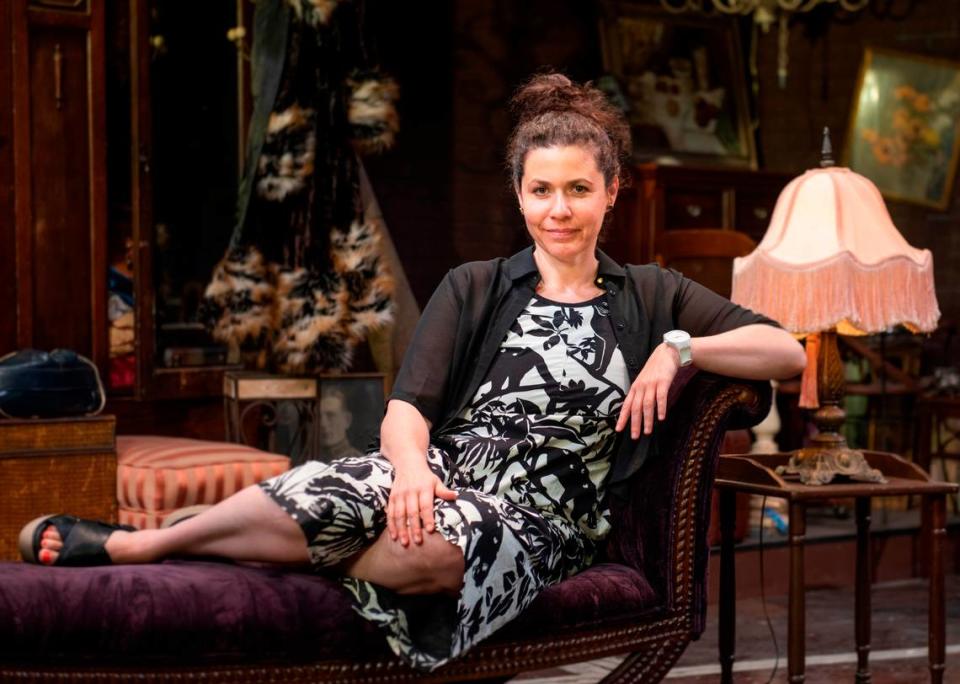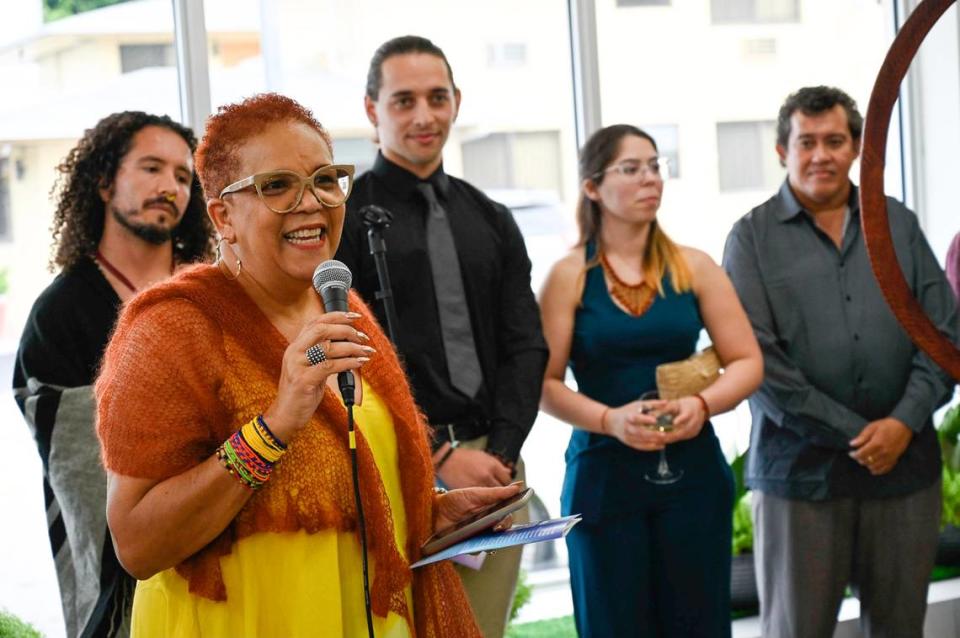How Miami arts organizations are putting artists of color in the forefront this season
- Oops!Something went wrong.Please try again later.
In just a few weeks time, giant hair braids will hang and twist around the palm trees outside of the Museum of Contemporary Art in North Miami. A Trinidadian soprano will take the stage opening night at the New World Center in Miami Beach. And throughout March, Miami’s high school students will watch a retelling of a Shakespearean comedy through the lens of Haitian immigrants.
As Miami’s art season approaches, artists of color are at the forefront.
Miami’s arts organizations — from visual arts to performance to music — are hosting upcoming projects that highlight artists, singers, musicians, playwrights, dancers, actors, designers and stories of color.
On one hand, it’s a given that many Miami arts institutions and groups say that they have always focused on showcasing diverse talent. Miami is unique compared to other American cities. It’s a gateway to the Caribbean and Latin America. Its foundation was built by Bahamian immigrants. The city itself wouldn’t even be a city had it not been for the Black residents of Overtown.
“If you’re trying to be reflective of your own demographics then, by nature, Miami’s going to be a little different than other places in the country,” said Franklin Sirmans, the Pérez Art Museum Miami director. “I think we reflect that by our commitment to Latin America and the Caribbean.”
Still, arts leaders and artists say it’s not enough to just be based in a diverse city. It’s not enough to include BIPOC artists in some programming. Supporting artists of color — and the communities they come from — is a task much bigger than just one season.
Since the Black Lives Matter protests following the murder of George Floyd in 2020, arts organizations have made a point to reflect on the moment and apply lessons learned to their programming.
“What we learned is that it is not just about putting out a statement, and it’s not just about saying, ‘Well, these are the things that we’ve done,’” said Lourdes Lopez, the artistic director of Miami City Ballet. “It’s about living it.”
Besides producing professional performances, Miami City Ballet has stressed the need to bring the art form to young Black and Latino children. The organization’s Ballet Bus scholarship program provides transportation, uniforms, tuition and snacks in order to make a ballet career possible for Miami youth.
“That hands down is making a tremendous impact in children’s lives,” said director for community engagement Monica Stephenson.

As a relatively new institution founded in 2014, the Institute of Contemporary Art, Miami has had a unique opportunity to “think of it as a 21st century collection” that prioritizes diverse programming from the outset, said artistic director Alex Gartenfeld.
In an effort to be as accessible as possible, he said, the museum is free to the public. About 90% of the museum’s discretionary funds have gone toward collecting work by BIPOC artists. And ICA features many Miami-based artists for the first time in their careers, Gartenfeld said. Inclusion is “built into the DNA of our organization.”
“The events of 2020 and the murder of George Floyd brought into clearer focus initiatives of our museum and many museums across the country had undertaken to ensure that we are as diverse and as equitable as we need to be,” he said. “And so our initiatives during that time, were, have been and continue to be multi pronged.”
The Adrienne Arsht Center for the Performing Arts intentionally selects works to promote diversity, said CEO Johann Zietsman. The center’s programming, which is consistently filled with BIPOC artists and productions, is a source of pride for him.
Besides plays, musicals and performances, Zietsman said that the Arsht has been dedicated to promoting diversity behind the scenes, especially since the Black Lives Matter protests of 2020. Zietsman said the organization furthered its diversity, equity and inclusion policies by implementing yearly reports and evaluations to determine what the Arsht can do better. The organization has prioritized BIPOC candidates for its paid fellowship and internship programs, he said.
“They come out the other side job ready,” Zietsman said. “It’s important that we focus on people of color for that to make sure there’s a pipeline.”
For Miami New Drama artistic director Michel Hausmann, diversity is not an initiative or goal. It’s just how they do things.
Compared to other art forms, he said, theater has been slower to embrace stories of color. About six years ago, when Hausmann started Miami New Drama, he recalled being told that Miami was not a “theater town.” After years of prioritizing Miami’s diverse stories, Miami New Drama has proven the naysayers wrong, he said.
Latino and African American audiences don’t respond to pandering, Hausmann said. They respond to authenticity.
“You talk to the community in the terms of the community,” Hausmann said. “You treat their stories as if you’re doing holy work.”
Still, arts leaders agree: despite Miami’s inherent diversity, the arts community has plenty of work to do if it wants to be a true beacon for artists of color. Here are the steps they’re taking this season.
‘Audiences need to see themselves in the work’
Many local arts organizations and museums are making efforts to showcase the work of artists of color. Oolite Arts CEO Dennis Scholl says that featuring works by BIPOC artists is how his organization engages community members.
“Audiences need to see themselves in the work,” Scholl said. “Audiences need to be able to come to an exhibition and see artists that reflect the audiences’ experiences.”
This season, Oolite plans to explore the Black American and Black Caribbean experiences.
Here are the visual art shows that Miami should be excited about this season
On Oct. 12, internationally recognized architect and Oolite alum Germane Barnes will debut his new installation “Rosie’s Fare,” a work inspired by his grandmother Rosie and the often underappreciated labor of African American women in spaces like the kitchen.
“It was important for me to celebrate her and to allow other people to see their own grandmothers in the work,” Barnes said. “The grandmother is such an important part of the Black family. Many families don’t exist without her.”
That same day, Dominican curator Danny Baez’s exhibition “Miami is Not the Caribbean. Yet it Feels Like it.” will open at Oolite as well. The show features artists of Caribbean heritage and artworks that ponder the question: Is Miami part of the Caribbean?
Through Dec. 4, the exhibition “Rafael Soldi: A body in transit” is on view at the Patricia and Philip Frost Art Museum at Florida International University. The show is a collection of photographs and portraits that deal with queerness, immigration and masculinity by Soldi, a Peruvian artist based in Seattle. The museum also will open “In the Mind’s Eye: Landscapes of Cuba,” an exhibition featuring several afro-Cuban artists, on Sept. 24.
In North Miami, MOCA is preparing two striking attractions by Black artists. On Oct. 14, artist VantaBlack’s work “To What Lengths” will take over the palm trees outside the front of the museum. The installation will be giant braids decorating the trees with cushions on the ground. The work is meant to invoke the comfort, bonding and vulnerability of a young Black child having their hair braided by a parent.

Inside the museum, starting Nov. 2, will be “Didier William: Nou Kite Tout Sa Dèyè,” an exhibition featuring a large body of work by William, a Haitian American artist and North Miami native.
“Navigating the different perceptions of various immigrant populations is something that he’s thinking about in his work, so giving that platform in North Miami it feels really important, especially given the demographics of this community,” said MOCA curator Adeze Wilford. “We always want people to feel represented when they come in this space.”

In the Design District, another prolific Haitian artist will be in the spotlight, too. Starting Nov. 29, “Hervé Télémaque: 1959–1964,” a collection of early works by contemporary artist Télémaque will open at ICA.
That same day, ICA will debut brand new works by Nina Chanel Abney, an acclaimed Black artist whose career has taken off in recent years, Gartenfeld said. The show’s name and premise is bound to capture visitors’ attention: “Big Butch Energy” is an exhibition about a Black lesbian navigating a rowdy, college fraternity.
“From the beginning of this exhibition’s development, Nina knew that she wanted the work to challenge audiences to think about the ways in which institutions and individuals are complicit in perpetuating ideas of identity and gender,” Gartenfeld said.
Theater that reflects the community
Miami’s theater groups and companies are preparing a season’s worth of productions that highlight Miami playwrights and stories local audiences can relate to.
The city is home to many notable playwrights of color whose work has deeply impacted theater and film, like Tarell Alvin McCraney, the writer behind the Academy-award winning film “Moonlight,” and Nilo Cruz, the Pulitzer-prize winning author of “Anna in the Tropics.”
This season marks the first time Cruz himself will direct a production of his iconic play with Miami New Drama, but political drama with the Miami-Dade County School District has entered stage left. “Anna in the Tropics” was thrust into the headlines when the school district denied students from attending Miami New Drama’s production of the play because of “sexually explicit” content.
Among Miami’s artistic community, the move is seen as the latest in a worrying trend of censorship.
Broadway hits and local debuts: These performances should get Miami theater fans excited
“It seems like we quickly got ourselves into a new cultural war and the students are losing,” Hausmann told the Herald. “We are restricting information. We think that students are not capable enough for critical thinking. And if we don’t raise a flag now, ‘Hey, what’s next? Burning the books?”
Along with “Anna in the Tropics,” which opens Jan. 12, Miami New Drama is premiering three ambitious plays that take place in Miami’s immigrant and Black communities, Hausmann said.
“Everything we do is a reflection of our community,” he said.
The season begins on Oct. 27 with the world premiere of “Elián,” a personal and intimate take on the story of Elián González, a Cuban boy who was caught in a heated custody battle and international controversy in 2000. The incident tore Miami apart emotionally and politically, so much so that it affected the outcome of the presidential election.
Miami New Drama interviewed several people with direct knowledge of González’s case, including the family lawyer, to bring new information and perspectives to light in a compassionate way, Hausmann said.
Hausmann, who commissioned playwright Rogelio Martinez for the play, said the piece is “the most important work we have ever done and we have yet to do because we are taking a moment that has been extremely traumatic for this community.”
“This play does more justice to the Miami community,” he said. “I think the media just wrote off ‘crazy Cubans’ and blamed the Miami family for the raid. This story shows a more nuanced reality.”

Starting March 9 is “Defacing Michael Jackson,” a coming-of-age story by screenwriter, playwright and Miami native Aurin Squire. The story is set in 1984 in the predominately Black community of Opa-Locka, Squire’s hometown. The story follows a group of local kids, obsessed with their idol Michael Jackson, who navigate growing up in a time of social and racial unrest.
On May 4 is the world premiere of “Create Dangerously,” based on the book by Haitian American author Edwidge Danticat. The play, which follows a Haitian woman making art in the United States, will be directed by Tony-nominated artist and Miami native Lileana Blain-Cruz.
For GableStage artistic director Bari Newport, who took the helm in April 2021, diversity has been a key element in rebuilding the theater and furthering late artistic director Joseph Adler’s legacy.
One of Newport’s initiatives was to “reimagine” the Shakespeare in the Schools Tour, GableStage’s flagship education program that brings adapted versions of classic Shakespeare works to Miami-Dade middle and high schools.
GableStage partnered with New World School of the Arts teacher Eddie Brown to direct a modern version of the romantic comedy “Twelfth Night” with Haitian immigrant characters.
The tour will visit about 20 schools through March.

“It was really important to us that we reimagined the inclusivity of where [the tour] goes, what schools it hits, and also what is reflected on stage to the high schoolers who are viewing it,” Newport said. “How to make Shakespeare exciting and accessible to all people; That’s the purpose of that program.”
Starting April 15, GableStage’s “centerpiece of the season” has its Florida premiere, Newport said.
“El Huracán” is a play written by Charise Castro Smith, a Miami native and co-director for Disney’s “Encanto.” The work, inspired by Shakespeare’s “The Tempest,” takes place in 1992 as Hurricane Andrew approached Miami and later during a fictionalized hurricane. The story focuses on a family of Latina women, their estranged relationships and the process of forgiveness.
“It’s really a story about the power of memory and the power and loss of forgetting,” Newport said. “It’s very much a woman’s story. There’s a lot of magic in it.”
Zoetic Stage, which performs its productions at the Adrienne Arsht Center, is tackling the work of Pulitzer Prize-winning playwright Lynn Nottage, the “most celebrated female Black writer” in theater, said artistic director Stuart Meltzer.
The group’s first production is Nottage’s “Mlima’s Tale,” which features an entirely local BIPOC cast and explores the harms of the elephant tusk trade. The play, which opens Oct. 13, tells the story of Mlima, an elephant trapped in the underground ivory market. “Mlima’s Tale” uses elements of film and live musicians who specialize in West African instruments to tell a unique and powerful story, Meltzer said.

Zoetic’s program will be capped with a world premiere of “#Graced” by Miami playwright Vanessa Garcia, known for writing “The Amparo Experience,” an immersive theater program about the Cuban family that created Havana Club rum.
The play, which follows the main character Catherine who embarks on a journey across America, is a funny, insightful take on “the evolution of the American dream,” Meltzer said.
“[The works] explore different points of view, perspectives, cultures,” he said. “Something that we hope will be a shared experience to create empathy.”
This upcoming season, along with Zoetic Stage’s plays, the Arsht Center has picked Broadway musicals that feature predominately BIPOC casts, including “Hadestown” and “Six.” Zietsman noted that as Broadway has become more inclusive over the years, it has been easier for the Arsht to bring diverse plays to Miami. The selection has simply grown.
Dance and Music
On Oct. 15, star Trinidadian soprano Jeanine De Bique will help celebrate New World Symphony’s 35th anniversary on opening night.
De Bique, an established singer who is set to perform around the world this season, will perform arias from a romance opera at the New World Center. Howard Herring, the New World Symphony president, said he looks forward to Miami’s Caribbean communities getting to listen to De Bique’s artistry.
Here are the top picks for classical music performances in South Florida this season
“When a star emerges from a community, in this case Trinidad, there’s always a pride that runs with that,” Herring said.

Miami City Ballet hopes to excite its multilingual and multicultural audiences with performances by choreographers, designers and writers of color. This follows last season’s work by acclaimed Black female choreographer Claudia Schreier.
New York-based choreographer Amy Hall Garner will team up with an all-women-of-color creative team to produce “Rita Finds Home,” a family-friendly ballet about a little girl who has to cope with being displaced by a hurricane. The performance is designed specifically for children’s matinees, Stephenson said.

“What really speaks to me about ‘Rita Finds Home’ is we are going to present a ballet for the community that’s relevant to the story of South Floridians,” Stephenson said.
The final program of the season was also made with Miami in mind, Lopez said.
Part of the last performance includes a reimagined version of George Balanchine’s “Square Dance.” Originally, the ballet had a caller who would sing “swing your partner round and round.” In this version, there will be a rapper spitting lyrics in Spanglish.
“Even though it was created in 1976 by this white Russian choreographer and even though it has steps from 500 years ago that we still do today in class, I want to show our audiences that with changing a few things, they can relate to it,” Lopez said. “They can have something that speaks to them.”
These are the dance performances you can’t miss in South Florida this season
‘Are we doing it enough?’
While Miami’s arts institutions and organizations have made strides in supporting BIPOC artists, leaders recognize that more can and should be done — especially given Miami’s housing crisis and soaring prices.
“There’s always more work to be done,” said Victoria Rogers, the vice president of the arts at the Knight Foundation. “You can’t rest on your laurels.”
In terms of supporting artists of color, Zietsman put it bluntly: “Are we doing it enough? No, I don’t think so.”
The rising cost of living is a major concern frequently noted. Though organizations like Oolite and the Knight Foundation invest millions of dollars into the careers of local artists, many struggle to afford living and working in Miami. Zietsman lamented the lack of paid work opportunities for performing artists.
“A lot of Miami talent leaves Miami because they feel [there are] more opportunities for them somewhere else,” Zietsman said. “And in many cases, they’re right.”
Black curators and artists noted another issue. Miami excels at featuring Latin American artists, but falls behind in supporting Black artists, both locally and internationally.
“I think Miami is leaps and bounds ahead of most cities, but everybody can stand to do a bit better,” Barnes said.
Black artists should be given the grace and space to learn from mistakes and imperfections to hone their craft, Barnes said. He credited organizations like Oolite for allowing emerging artists of color to get opportunities without needing an established career first.
“Black people deserve the opportunity to fail because we learn so much from failures. We don’t get that opportunity,” Barnes said. “You need to already be established or you need to already know what’s going on because if you fail, you may never get that opportunity.”
For decades, curator Rosie Gordon-Wallace has worked in Miami — and around the world — promoting artists of color with her organization, the Diaspora Vibe Cultural Arts Incubator. She can say with confidence: Miami needs to boost its Black artists.

To her, Miami does not stand out as a leader in showing Black and brown artists in comparison to cities like New Orleans or Los Angeles. Miami certainly has the desire to emerge as a leader, but that’s a status it has not achieved, she said.
The city needs more physical spaces dedicated to showing and supporting Black artists, she said. As an organization, the Miami Museum of Contemporary Art of the African Diaspora regularly hosts and supports several events and exhibitions for Black art, despite not yet having a physical museum space of its own.
“Are there many spaces to show Black and brown artists? Is desire enough?” Gordon-Wallace said. “It’s not enough to have this desire. I genuinely don’t think we’re there yet.”
For the rest of the season, she plans to do what she always does: getting her artists the representation they deserve. She recently curated an exhibition at Green Space Miami that highlights the identity of the Caribbean diaspora, which is on view until Oct. 20.
Curator Chris Norwood agreed with Gordon-Wallace.
“African American artists get lost in the landscape of the Miami art world, in my opinion,” he said.
Norwood is the founder of Hampton Art Lovers and curator at the Historic Ward Rooming House’s art gallery in Overtown, a space that features work by Black artists. In November, he will open “Charles White: Move on Up,” an exhibition on the African American artist in partnership with the University of Miami’s Lowe Art Museum.

Though Miami’s art world has acknowledged that Black art is profitable, the community is still deficient in spaces to display and consume Black art year round, Norwood said.
More often than not, he said, the responsibility of promoting Black American art in Miami falls on Black Americans. Overtown is a prime example of a Miami neighborhood that is experiencing a “renaissance” of Black art, he said.
“We are doing it ourselves,” Norwood said. “We’re occupying that space with our own self determination.”
It’s up to everyone else to catch up.
This story was produced with financial support from The Pérez Family Foundation, in partnership with Journalism Funding Partners, as part of an independent journalism fellowship program. The Miami Herald maintains full editorial control of this work.

